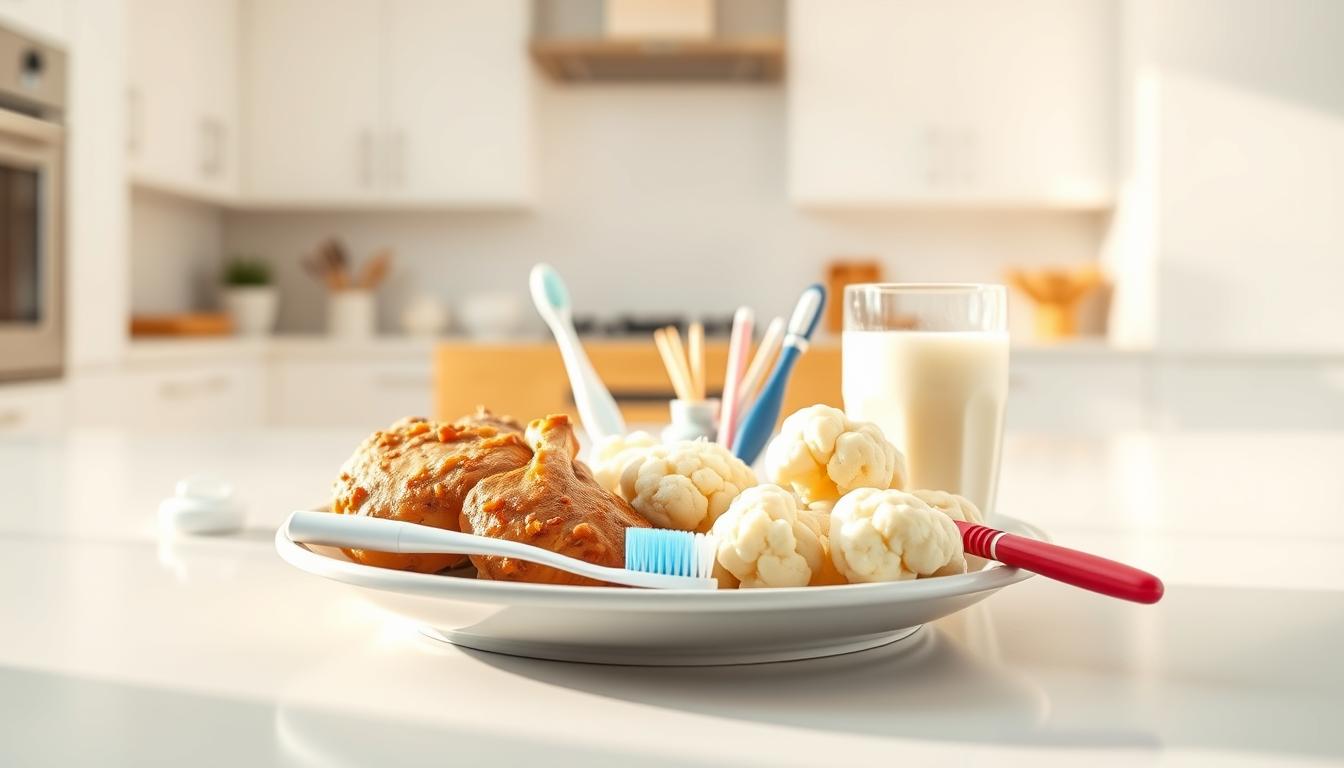February 5, 2025 lori
What is the “White Diet” ?

The White Diet is key for keeping your smile bright after teeth whitening. It’s important to stick to this diet to get the best results. This diet tells you what foods to eat and avoid to keep your teeth white.
Teeth whitening makes your teeth look better. But, to keep them looking great, you need to follow the White Diet. It helps keep your teeth white and prevents stains. By sticking to the White Diet, you can keep your smile healthy and beautiful for longer.
After whitening your teeth, taking good care of them is crucial. The White Diet is a big part of this care. It helps you avoid foods and drinks that can stain your teeth. Knowing how important the White Diet is, you can take steps to keep your smile bright.
Key Takeaways
- The White Diet is a set of dietary guidelines to follow after teeth whitening
- It helps maximize the results of teeth whitening and maintain a bright smile
- Post-whitening care is crucial to the success of your teeth whitening treatment
- The White Diet helps you avoid foods and drinks that can stain your teeth
- Following the White Diet can help you enjoy a healthy and beautiful smile for a longer period
- Teeth whitening is a popular cosmetic procedure that can improve the appearance of your teeth
- The White Diet is an essential part of your post-whitening care routine
Understanding the White Diet and Its Importance
The White Diet is key for keeping your teeth white after whitening. It helps prevent stains and keeps your teeth bright. This diet is vital for dental care and oral health, keeping your smile healthy.
Knowing what foods to avoid and what to eat is crucial. A diet rich in gentle foods helps keep your oral health in check. Safe foods include:
- White meats like chicken and turkey
- Fish like cod and salmon
- White fruits like bananas and apples
- Vegetables like broccoli and cauliflower
By sticking to the White Diet, you can keep your smile bright. Remember to also brush and floss regularly. This keeps your teeth and mouth clean and healthy.
In the next section, we’ll explore the science behind post-whitening food restrictions. We’ll see how they affect your oral health.
The Science Behind Post-Whitening Food Restrictions
After teeth whitening, it’s key to think about how food and drink affect your dental hygiene and smile care. Some foods and drinks can make your teeth more sensitive. That’s why it’s important to follow food restrictions after whitening. Knowing why these restrictions are needed can help you choose better foods and drinks.
It’s important to avoid foods and drinks that can stain or harm your teeth, especially in the first 48 hours after whitening. This includes foods with strong colors like berries and turmeric. Also, acidic drinks like citrus juice and soda should be avoided. By being careful with what you eat and drink, you can keep your smile care in check and avoid teeth sensitivity.
- Opting for mild flavors and avoiding strong colors
- Choosing water and other non-acidic beverages
- Avoiding hot or cold foods and drinks to reduce teeth sensitivity
By sticking to these tips and focusing on your dental hygiene, you can have a healthy, beautiful smile. This way, you can also lower the chance of teeth sensitivity.
Foods to Eat After Professional Teeth Whitening and Foods to Avoid for 48 Hours
After getting your teeth whitened, it’s important to watch what you eat and drink. Eating right helps keep your teeth looking good. For the first 48 hours, eat foods and drinks that are gentle on your teeth and won’t stain them.
Choosing the right foods is key for your teeth’s health. Here are some safe options:
- Bananas
- Yogurt
- Chicken
- White fish
- White bread
But, there are foods and drinks to avoid for 48 hours. They can stain or harm your teeth. Here’s what to skip:
- Berries
- Tomatoes
- Curry
- Red wine
- Coffee
By eating right and taking care of your teeth, you can keep them white and healthy. Always put your dental health first for a beautiful smile.
White Diet-Approved Meal Planning
Meal planning is key in the White Diet for dental care and oral health. It ensures a balanced diet that boosts your health. Stick to food restrictions to keep your mouth and teeth healthy.
Here are some meal planning ideas to get you started:
Breakfast Options
- Oatmeal with fruits and nuts
- Scrambled eggs with whole-grain toast
- Yogurt with granola and berries
Lunch Ideas
- Grilled chicken with roasted vegetables
- Whole-grain pasta with marinara sauce and lean ground beef
- Lentil soup with whole-grain bread
Dinner Suggestions
- Grilled salmon with quinoa and steamed broccoli
- Chicken stir-fry with brown rice and mixed vegetables
- Vegetable curry with whole-grain rice and naan bread
Common Mistakes to Avoid During Your White Diet
When you’re on the White Diet, watch out for common mistakes. These can mess up your teeth whitening results. A big worry is teeth sensitivity, which gets worse with hot or cold foods and drinks. Keeping up with dental hygiene and smile care is key.
Some common mistakes to steer clear of include:
- Staying away from foods and drinks that stain or harm your teeth, like berries, coffee, and red wine
- Not brushing your teeth often, which can cause plaque and ruin the whitening effect
- Not sticking to a regular dental hygiene routine, including flossing and mouthwash
To get the most out of your teeth whitening, focus on smile care and avoid these mistakes. Being careful with what you eat and drink, and keeping up with dental hygiene, will help you get a brighter, healthier smile.
By following these tips and avoiding common errors, you can keep your dental hygiene and smile care in top shape. This reduces teeth sensitivity and ensures the best results from your teeth whitening.
Tips for Maintaining Your Bright Smile Beyond 48 Hours
To keep your smile bright after teeth whitening, you need good oral hygiene and dental health habits. A daily routine that promotes healthy teeth care is key. This helps your teeth stay in top shape.
Daily Dental Care Routine
Brush your teeth at least twice a day with fluoride toothpaste. Floss once a day and rinse with antibacterial mouthwash. Also, don’t forget regular dental check-ups and cleanings for a healthy smile.
Long-term Dietary Considerations
Choose your food wisely to support your oral hygiene and dental health. Avoid sugary and acidic foods and drinks. They can harm your teeth. Instead, eat a balanced diet with fruits, vegetables, and whole grains.
Follow these tips for a bright and healthy smile for years. Always put your dental health and teeth care first. This way, you’ll have a beautiful and confident smile.
The Role of Temperature in Post-Whitening Care
Temperature is key in caring for your teeth after whitening. Extreme temperatures can make your teeth more sensitive. It’s important to watch the temperatures of what you eat and drink to keep your teeth healthy.
Try to avoid very hot or cold foods and drinks. They can make your teeth hurt. Instead, choose things that are lukewarm or at room temperature. This helps keep your teeth comfortable and your smile looking great.
Here are some tips to handle temperature sensitivity during the White Diet:
- Drink water at room temperature to stay hydrated
- Avoid hot beverages like coffee and tea
- Have lukewarm soups and broths
- Eat foods at room temperature to reduce discomfort
By following these tips, you can reduce teeth sensitivity and have a smooth recovery. Always remember to take care of your teeth and smile to keep them healthy and beautiful.
Managing Hunger and Cravings During the White Diet
Staying on the White Diet can be tough, especially when hunger and cravings hit. To keep your mouth healthy, it’s key to choose wisely. Drinking plenty of water and eating small meals often can help. This way, you avoid eating too much and keep your teeth in good shape.
It’s also important to pick healthy alternatives. Instead of sweets, try sugar-free gum or fresh fruits. Being careful with how much you eat is another must. Using smaller plates and measuring food helps you eat just the right amount. This supports a healthy diet and keeps your teeth strong.

Healthy Substitutions
- Choose sugar-free snacks to reduce the risk of tooth decay
- Select fruits and vegetables that are gentle on teeth, such as apples and carrots
- Opt for water or unsweetened tea instead of sugary drinks
Portion Control Strategies
Keeping an eye on food portions is key for a balanced diet and healthy teeth. Being mindful of what you eat helps prevent overeating. This supports your dental health and overall well-being.
When to Resume Normal Eating Habits
After 48 hours, it’s time to slowly go back to eating as you normally do. This helps keep your teeth whitening results looking great. Make sure to take good care of your dental care and oral health to keep your smile shining.
When you start eating normally again, keep these food restrictions in mind for your oral health:
- Avoid staining foods and drinks for a few more days
- Choose foods that are gentle on your teeth, such as dairy products and fruits
- Drink plenty of water to stay hydrated and help rinse away any remaining bacteria
By following these tips and focusing on dental care, you can enjoy your favorite foods. And still have a healthy, bright smile. Always talk to your dentist for advice on oral health and food restrictions after whitening your teeth.
Professional Advice and Expert Recommendations
Keeping your smile healthy and beautiful is key. Dentists stress the need for regular dental visits and cleanings. These steps help prevent teeth sensitivity and keep your teeth strong.
What you eat and drink matters a lot. Some foods can harm your teeth, while others help them stay healthy. For instance, sugary and acidic foods can lead to cavities. But, foods full of calcium and fiber are good for your teeth and gums.
Dental experts say a balanced diet is vital for your teeth. Eating fruits, veggies, whole grains, and lean proteins is important. Also, drinking lots of water helps clean your mouth and prevent sensitivity.
Dentist-Approved Guidelines
- Brush teeth at least twice a day with a fluoride toothpaste
- Floss once a day to remove food particles and plaque
- Visit the dentist for regular check-ups and cleanings
Warning Signs to Watch For
Pay attention to any changes in your mouth. Increased sensitivity or bleeding gums are red flags. If you see these signs, see a dentist right away to find out why and get treatment.
Conclusion: Making the Most of Your Teeth Whitening Investment
In conclusion, the oral hygiene and dental health benefits of the White Diet are key. They help keep your teeth care treatment looking great. By following the tips in this article, your teeth will stay bright and healthy for years.
Consistency is crucial. Stick to your daily dental routine. If you have questions or concerns, don’t hesitate to contact your dentist. With proper care, you’ll have a smile that boosts your confidence and impresses everyone.

